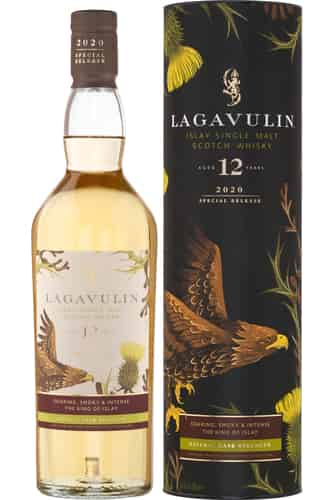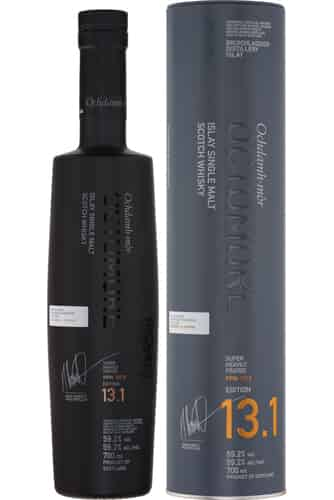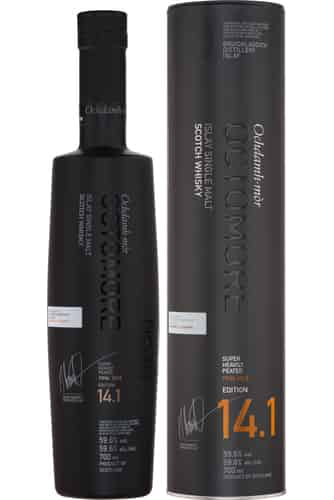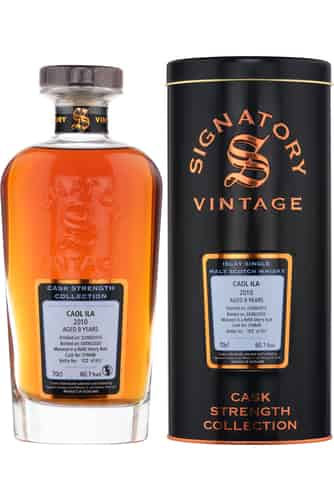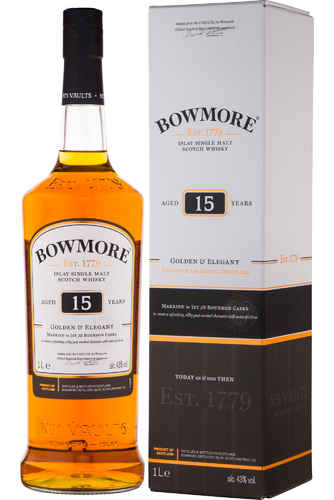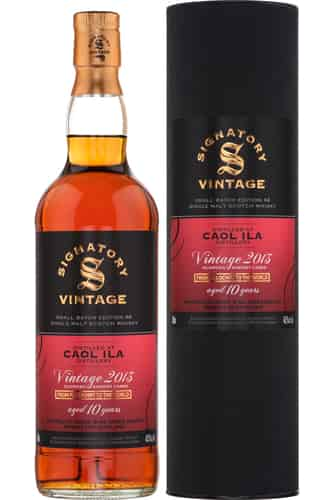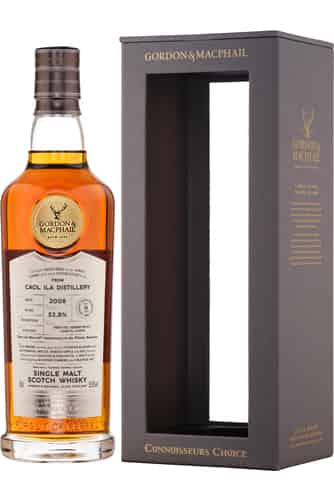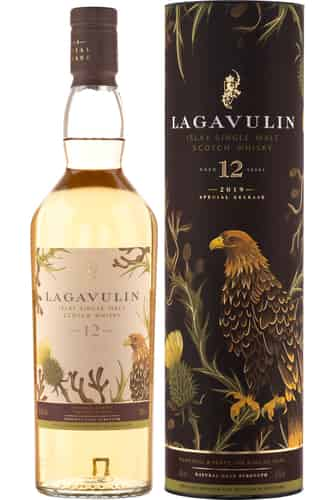
Lagavulin 12 Year Old (2019 Special Release)
70 cl, 56.5%In stock128.80 €- Save
16.00 €
Octomore 10.2
70 cl, 56.9%In stock143.20 €159.20 € ![]()
Lagavulin 12 Year Old (2020 Special Release)
70 cl, 56.4%In stock128.80 €- Save
16.00 €![]()
Octomore 13.1
70 cl, 59.2%In stock127.20 €143.20 € ![]()
Bunnahabhain 10 Year Old 2012 (Cask #900604) - Signatory Cask Strength
70 cl, 64.9%In stock114.40 €![]()
Octomore 14.2
70 cl, 57.7%In stock159.20 €- Save
16.00 €![]()
Octomore 13.2
70 cl, 58.3%In stock143.20 €159.20 € ![]()
Caol Ila 16 Year Old 2007 (Cask #5) - Signatory Cask Strength
70 cl, 58.5%In stock137.60 €![]()
Octomore 12.2
70 cl, 57.3%In stock159.20 €![]()
Port Charlotte MC: 01 2009
70 cl, 56.3%In stock111.20 €![]()
Bunnahabhain 12 Year Old
70 cl, 46.3%In stock48.00 €![]()
Octomore 14.3
70 cl, 61.4%In stock207.20 €![]()
Bruichladdich Barley Exploration Collection - 3 x 20 cl
60 cl, 50%In stock63.20 €![]()
Bowmore 10 Year Old Aston Martin Edition (1 Liter)
100 cl, 40%In stock73.60 €![]()
Octomore 15.2
70 cl, 57.9%In stock159.20 €- Save
11.20 €![]()
Caol Ila 11 Year Old 2010 (Cask #107) - Signatory Cask Strength
70 cl, 57.1%In stock100.00 €111.20 € ![]()
Octomore 15.1
70 cl, 59.6%In stock148.80 €![]()
Bowmore 18 Year Old Deep & Complex
70 cl, 43%In stock103.20 €![]()
Bunnahabhain Abhainn Araig - Fèis Ìle 2022
70 cl, 50.8%In stock103.20 €- Save
16.00 €![]()
Octomore 13.3
70 cl, 61.1%In stock183.20 €199.20 € ![]()
Octomore 14.1
70 cl, 59.6%In stock148.80 €![]()
Lagavulin Distiller's Edition
70 cl, 43%In stock97.60 €![]()
Lagavulin 12 Year Old (2022 Special Release)
70 cl, 57.3%In stock139.20 €![]()
Ardbeg Smoketrails Côtes Rôties Edition (1 Liter)
100 cl, 46%In stock104.80 €![]()
Ardbeg Smoketrails Manzanilla Edition (1 Liter)
100 cl, 46%In stock110.40 €- Save
9.60 €![]()
Kilchoman Small Batch - Bourbon & Oloroso & Cognac
70 cl, 50.6%In stock81.60 €91.20 € - Save
11.20 €![]()
Caol Ila 9 Year Old 2010 (Cask #316648) - Signatory Cask Strength
70 cl, 60.1%In stock100.00 €111.20 € ![]()
Laphroaig 10 Year Old
70 cl, 40%In stock39.20 €![]()
Laphroaig Port Wood
70 cl, 48%In stock119.20 €![]()
Octomore 7 Year Old 2008 French Oak (Cask #200800908) - Rest & Be Thankful
70 cl, 63.9%In stock223.20 €![]()
Octomore 7 Year Old 2007 Sauternes (Cask #2007003810) - Rest & Be Thankful
70 cl, 63.9%In stock223.20 €![]()
Bunnahabhain 14 Year Old 2009 (Cask #358) - Connoisseurs Choice (Gordon & MacPhail)
70 cl, 57.6%In stock118.40 €![]()
Lagavulin 16 Year Old
70 cl, 43%In stock87.20 €![]()
Lagavulin 8 Year Old
70 cl, 48%In stock63.20 €![]()
Bowmore 15 Year Old Golden & Elegant (1 Liter)
100 cl, 43%In stock63.20 €- Save
7.20 €![]()
Bunnahabhain Eirigh Na Greine (1 Liter)
100 cl, 46.3%In stock60.00 €67.20 € ![]()
Port Charlotte 11 Year Old 2004 Bourbon (Cask #2004000959) - Rest & Be Thankful
70 cl, 59.7%In stock159.20 €![]()
Bruichladdich The Laddie Eight 8 Year Old
70 cl, 50%In stock60.00 €![]()
Caol Ila 10 Year Old 2013 - Small Batch Edition #4 - Signatory Vintage
70 cl, 48.2%In stock65.60 €![]()
Caol Ila 11 Year Old 2010 (Cask #103) - Signatory Cask Strength
70 cl, 57%In stock112.00 €![]()
Laphroaig Four Oak (1 Liter)
100 cl, 40%In stock55.20 €![]()
Caol Ila 14 Year Old 2008 (Cask #312058) - Connoisseurs Choice (Gordon & MacPhail)
70 cl, 52.8%In stock130.40 €![]()
Ardbeg Uigeadail
70 cl, 54.2%In stock76.80 €- Save
9.60 €![]()
Kilchoman Small Batch - Bourbon & Oloroso & Fino
70 cl, 49.2%In stock81.60 €91.20 € ![]()
Kilchoman Batch Strength
70 cl, 57%In stock76.80 €![]()
Caol Ila 12 Year Old
70 cl, 43%In stock44.00 €![]()
Port Charlotte 10 Year Old
70 cl, 50%In stock64.00 €![]()
Ileach Cask Strength
70 cl, 58%In stock41.60 €![]()
Caol Ila 17 Year Old 2006 (Cask #306193) - Connoisseurs Choice (Gordon & MacPhail)
70 cl, 58.3%In stock154.40 €![]()
Laphroaig The 1815 Legacy Edition
70 cl, 48%In stock92.00 €![]()
Port Charlotte PAC: 01 2011
70 cl, 56.1%In stock111.20 €![]()
Ardbeg The Three Monsters of Smoke - 3 x 20 cl
60 cl, 46.67%In stock47.20 €![]()
Saint & Peat Heavily Peated 2023
70 cl, 55%In stock43.20 €![]()
Finlaggan Port Finished
70 cl, 46%In stock39.20 €![]()
Laphroaig Lore
70 cl, 48%In stock100.00 €![]()
Kilchoman Sanaig
70 cl, 46%In stock55.20 €- Save
8.00 €![]()
Port Charlotte SC: 01 2012
70 cl, 55.2%In stock108.00 €116.00 € ![]()
Laphroaig 10 Year Old Cask Strength Batch 16
70 cl, 58.5%In stock92.00 €![]()
Elements of Islay Sherry Cask
70 cl, 58.3%In stock62.40 €![]()
Bruichladdich Islay Barley 2013
70 cl, 50%In stock63.20 €
Sorry, we didn't find anything. Please try changing your search criteria.
Islay History
Out in the wilds of the North Atlantic lies Islay, the Queen of the Hebrides. An unassuming island, a glance over a map would never suggest that this small community of just over 3000 people is one of the great drink producing regions on the planet. Islay is a true icon of the whisky world, with 8 active distilleries, including some of the best known and bestselling across the globe. These distilleries produce malts that thunder with power and drams that dazzle with complexity. Whisky made in Islay is closely tied to environment of the place, with their distinctive smoky flavour produced using peat from local bogs, and the briny undercurrents coming from the ocean waves that often crash against the warehouses. Islay whisky is a truly Scottish institution.
Islay whisky is believed to have a history stretching back to the 14th century, when Irish monks arrived at the island. Whilst Islay is a rugged and somewhat unforgiving place, the monks found a location perfect for distillation, with a ready and endless supply of peat and flowing soft waters from the lochs and rivers. Bere, a precursor the modern barley, was also grown to support the subsistence living of the islanders, yet this often produced a surplus- ideal for brewing and whisky making. In these early centuries, distillation was a monastic and cottage industry, with farmers seeking to avoid crop wastage, very different to the mass production we know today.
Indeed, the spirit itself was rather different to what modern drammers are used to. Clear and vodka like, the warm golden colour we are now familiar with came later as a side effect of storing and moving the drink in wooden barrels. It also had an extremely high strength, as the remarkably named 17th century travel writer Martin Martin attests to:
… the first taste affects all the members of the body: two spoonfuls of this last liquor is a sufficient dose; and if any man should exceed this, it would presently stop his breath, and endanger his life.
This, perhaps the world’s first tasting note, describes usquebaugh-baul, which translates as “perilous whisky”, a spirit that was sometimes quadrupled distilled. In the centuries that followed, distillers often found themselves on the wrong side of the law, and illegal distilling was particularly rife in Islay, a place that government officials avoided due to the “wild and barbarous people”.
Distilling as we know it began with the easing of restrictions on whisky production at the beginning of the 19th century. A little before this, Bowmore was founded, now the oldest distillery on the Island. In time it has been joined by seven other, distilleries (Ardbeg, Bruichladdich, Bunnahabhain, Caol Ila, Kilchoman, Laphroaig, Lagavulin) and has seen many others come and go.
Peat has come to define Islay. This thick soil-like substance is a type of degraded ancient vegetation, which can be dried and burnt for fuel (much of the peat on Islay is over 8000 years old, dating back to the time of Woolly Mammoths), in distilling, peat is used to dry and flavour the malt, giving it a distinctive smokiness.
Whilst it is true many Islay distilleries have the similarity of producing peated whisky each offers something different, and something worth exploring. Laphroaig is known for its particularly maritime style, with heavy iodine flavours and a medicinal nature. Ardbeg has a heavy ashy quality, and oily mouthfeel. Lagavulin has been compared to cognac, and is typically sherried, but retains a peaty intensity. This trio are known as the “Kildarton Cross” distilleries, and they lie in close proximity along the island’s south coast.
To the north is Caol Ila, the largest distillery on the island, which has a gentler peat and a distinct grassy note. Close at hand is Bunnahabhain, notably as it produces largely an unpeated whisky, with a toffee and chocolate profile (it has recently made some forays into peated whisky, with great success).
Then to the west are three more distilleries, Bowmore, Bruichladdich and Kilchoman. Bowmore is the elder statesman of Islay malts, reflected in its balanced and restrained peat. On the other end of the scale are Islay’s unruly teenagers, Bruichladdich, who has recently undergone a revam, and Kilchoman, the newest distillery on the island. Bruichladdich is known for its creative cask and progressive approach, producing fine unpeated whisky, alongside its outrageous super heavily peated Octomore line; whilst Kilchoman has challenged preconceptions about young whiskies, and produces many furiously fiery youthful expressions, with a crisp ashiness.
As the last two distilleries attest, Islay whisky has an impressive future to look forward to, as well as an astonishing past to reflect on. Despite the polarising effects of peat, these distilleries produce some of the best selling and best loved malts in the world. Things look set to continue, as Bruichladdich revives the Port Charlotte brand from its dormant state, and planning permission is granted for a ninth distillery- Gartbreck. If this means more delicious Islay whisky, then that is something we can all raise a dram to.
Did you know?
If Islay was to become independent, it would have one of the highest GDP’s per capita in Europe, due to the low population and impressive revenue from whisky production.


